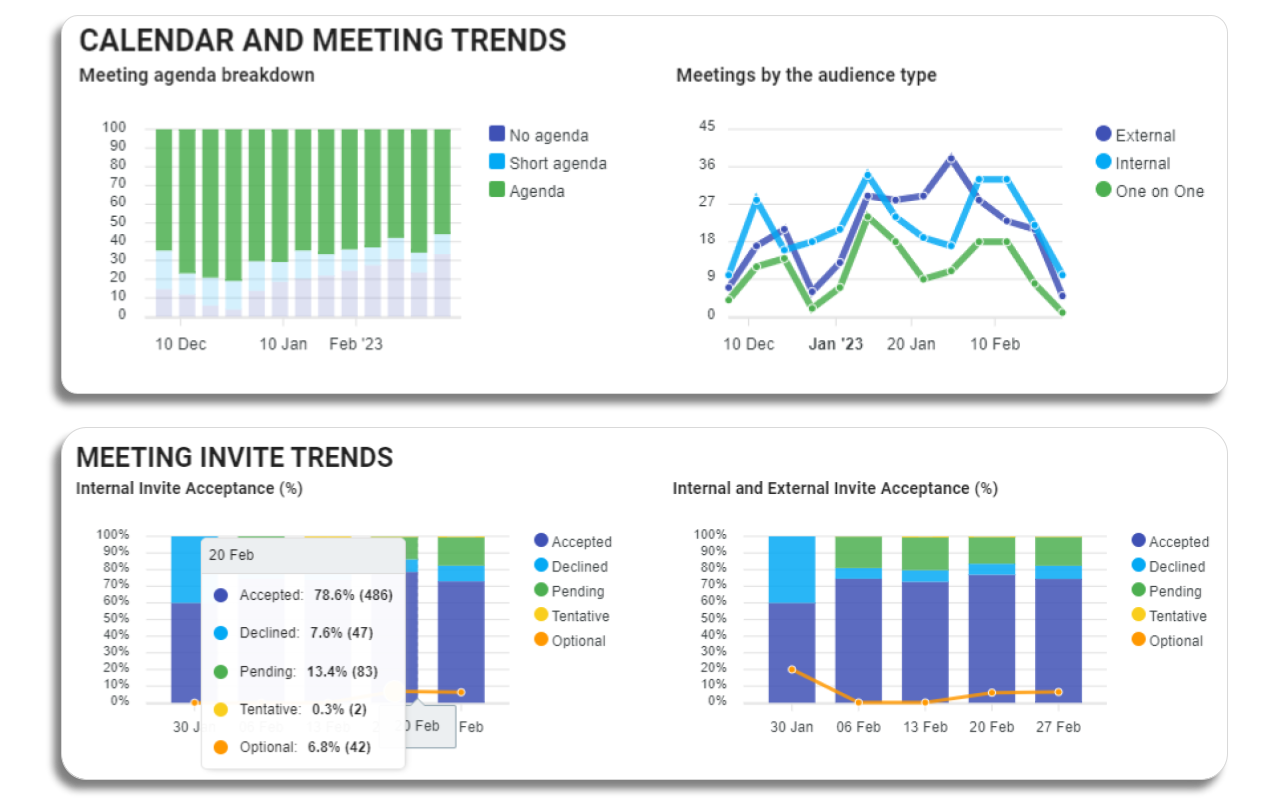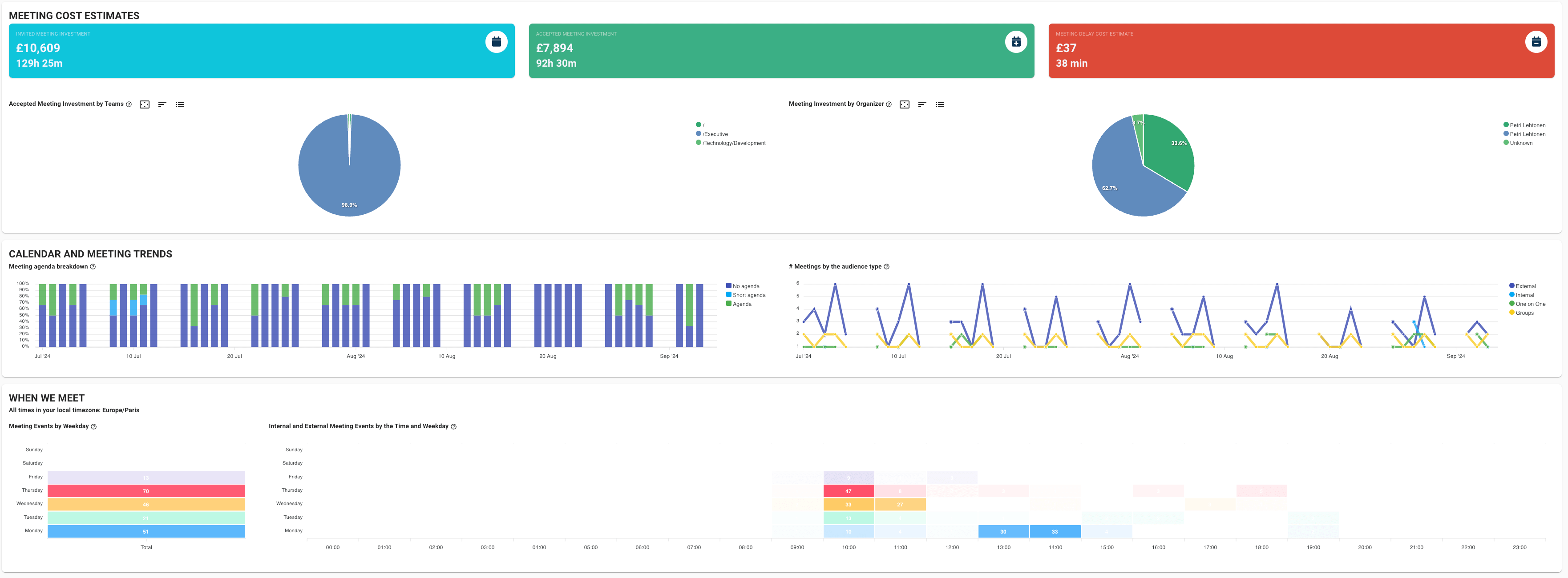State of Meetings Report 2025
This state of meetings report is to understand the current meeting landscape, trends, and key data to optimize and improve company meeting culture.
Improve meeting agenda effectiveness with this simple guide. Discover key strategies to improve clarity, time management, and decision-making for impactful outcomes.
A well-structured agenda is the backbone of any productive meeting. It sets clear expectations, defines key discussion points, and ensures that time is spent efficiently. When done correctly, an agenda transforms a meeting from an aimless conversation into a results-driven session with actionable outcomes.
However, despite its importance, agenda effectiveness is often overlooked. Many meetings either lack an agenda altogether or have one that is too vague to provide real structure. Without clear objectives, discussions become scattered, meetings run over time, and participants leave without clear next steps. In fact, 64% of recurring meetings and 60% of one-off meetings are scheduled without a single character in the agenda, leading to wasted time and frustration.
This article explores why meeting agenda validation is crucial and how organizations can ensure their agendas are not just present, but truly effective.
A well-defined agenda is a roadmap that keeps discussions focused, prevents unnecessary delays, and ensures participants walk away with clear next steps.

However, despite its importance, Flowtrace meeting stats reveals that 64% of recurring meetings and 60% of one-off meetings have zero characters in their agenda. Without structure, meetings quickly become unproductive, leading to wasted time and disengaged participants.
An agenda sets expectations by defining objectives before the meeting even begins. It helps attendees understand why they’re there, what they need to prepare for, and how they can contribute. When meetings lack this clarity, discussions meander aimlessly, making it difficult to stay on track or achieve meaningful outcomes.
Meetings frequently overrun their scheduled time, disrupting workflows and reducing overall efficiency. A well-structured agenda helps prevent this by allocating specific time slots to each discussion point. However, when meetings proceed without an agenda, they tend to stretch beyond their intended duration, one of the reasons many employees feel overwhelmed by excessive meetings. By ensuring that every meeting follows a clear structure, organizations can reclaim valuable work hours and reduce unnecessary disruptions.
Meetings should lead to decisions and actionable next steps, not just open-ended discussions. A structured agenda ensures that key topics are addressed efficiently and that responsibilities are assigned. Without one, meetings often end without clear conclusions, requiring additional follow-ups and creating unnecessary back-and-forth. Given that the majority of meetings lack any formal agenda, it’s no surprise that organizations struggle with accountability and effective decision-making.

An agenda is not a checklist, it guides meetings toward productive outcomes. However, many organizations fall into the trap of creating agendas that are either too vague or lack actionable items, leading to ineffective meetings. In fact, a study highlighted by Forbes found that ineffective meetings cost businesses approximately $37 billion annually.
Agenda validation is the process of ensuring that a meeting agenda is clear, structured, and actionable. This involves critically assessing the agenda to confirm that it aligns with the meeting's objectives and provides a roadmap for discussion.
By validating agendas against these criteria, organizations can optimize meetings, thereby reducing the substantial costs associated with unproductive meetings.

Creating an agenda is only the first step, ensuring it actually improves meeting efficiency is where the real challenge lies. Many meetings follow an agenda on paper but fail to stick to it in practice, leading to wasted time and minimal decision-making. In fact, research shows that only 37% of meetings actively result in decisions. This highlights a critical issue: an agenda is ineffective if it doesn’t drive meaningful discussions and outcomes.
To assess whether your agendas are working, leaders should focus on these four key metrics:
If discussions frequently drift off-topic, the agenda isn't being followed effectively. This often results in longer meetings, unresolved issues, and the need for additional follow-ups.
How to track it:
Even with an agenda, poor time management can derail meetings. Some important topics may be rushed, while others (often less critical) consume too much time.
How to track it:
A meeting agenda should facilitate decision-making. If discussions are happening without clear outcomes, the agenda isn’t effectively guiding the meeting.
How to track it:
If attendees are disengaged, multitasking, or skipping meetings entirely, the agenda may not be structured in a way that keeps them engaged.
How to track it:

A missing or ineffective agenda does more than just make meetings unproductive, it carries significant hidden costs for organizations. From wasted time to lost productivity and direct financial implications, the consequences of poorly structured meetings extend beyond frustration.
Without a clear agenda, meetings often lack structure, leading to lengthy discussions that fail to reach a conclusion. When attendees enter a meeting without knowing what will be covered or what decisions need to be made, time is wasted debating priorities or backtracking on previous discussions. This lack of direction results in meetings running over their scheduled time, creating a chain reaction of delayed tasks and overlapping commitments.
The impact: Employees are forced to attend longer meetings than necessary, reducing the time available for focused, high-value work. Over time, this inefficiency compounds, making it harder for teams to meet deadlines and manage workloads effectively.
Every minute spent in an unproductive meeting is a minute taken away from deep work, client projects, and strategic thinking. Meetings that lack focus lead to repetition, requiring additional follow-ups to clarify what was discussed or to finalize decisions that should have been made the first time. This disrupts employee concentration, as frequent interruptions prevent individuals from completing complex tasks that require sustained attention.
The impact: Research suggests that employees spend an average of 31 hours per month in unproductive meetings. When compounded across an entire organization, this lost time directly reduces overall efficiency and output.
Ineffective meetings don’t just waste time, they waste company resources. Every participant in a meeting represents a financial cost, as their salaries are effectively being spent on that time. When meetings are poorly structured, include unnecessary attendees, or extend beyond their scheduled duration, the cost escalates.
The impact: Studies estimate that companies collectively waste $37 billion annually on unproductive meetings. The financial toll is even higher for large organizations, where unnecessary meetings can amount to millions in lost productivity and salaries spent on discussions that fail to drive real outcomes.
To avoid these costly pitfalls, organizations must enforce structured agendas that:
By prioritizing agenda effectiveness, businesses can reclaim wasted time, improve productivity, and significantly reduce the financial impact of ineffective meetings.

A well-structured agenda is the foundation of an effective meeting, but simply having one isn’t enough, it must be clear, relevant, and properly enforced. Organizations can take several strategic steps to improve agenda effectiveness, ensuring that meetings stay on track, drive meaningful discussions, and result in actionable outcomes.
One of the biggest reasons agendas fail is inconsistency. Some are too vague, others overly complex, and many lack clear action points. Standardizing agenda formats ensures every meeting follows a structured approach. A well-designed agenda should include:
Agendas that are drafted minutes before a meeting or not shared in advance lead to disorganized discussions. Requiring agendas to be prepared and shared before the meeting allows participants to review topics, prepare contributions, and bring relevant materials. Ideally, meeting agendas should be sent at least 24-48 hours in advance to maximize effectiveness.
The benefit: Pre-meeting agendas improve engagement, as attendees arrive ready to contribute rather than spending the first few minutes figuring out the meeting’s purpose.
Every agenda should be directly tied to the intended purpose of the meeting. One of the most common pitfalls is including unrelated discussion points, which lead to unfocused conversations and wasted time. Leaders should:
Meetings without a strong connection between the agenda and objectives are more likely to result in follow-up sessions that could have been avoided with better preparation.
Rather than having a meeting organizer create an agenda in isolation, encourage participants to contribute. Allowing attendees to add relevant discussion points ensures that meetings address key concerns and don’t overlook critical topics. However, contributions should be reviewed to prevent unnecessary additions that may derail the meeting.
The benefit: A collaborative agenda fosters greater engagement and ownership, leading to more productive discussions and better alignment on priorities.
Meeting analytics tools can help track agenda adherence and ensure meetings stay focused. Features like:
Improving agenda effectiveness requires consistency and commitment. By implementing these steps, organizations can ensure meetings are well-structured, efficient, and purpose-driven, leading to more productive discussions and fewer wasted hours.

Even with the best practices in place, many organizations struggle to consistently enforce agenda usage and ensure that meetings stay structured. Flowtrace provides powerful analytics and automation tools to help companies validate and optimize their meeting agendas, ensuring meetings remain focused, productive, and actionable.
One of the biggest challenges organizations face is simply ensuring that agendas exist in the first place. Flowtrace monitors whether meetings have agendas and evaluates their level of detail. By tracking:
Flowtrace helps leaders identify gaps and reinforce better meeting habits. If a high number of meetings continue to lack agendas, it becomes clear where intervention is needed to improve meeting culture.
A major advantage of Flowtrace is its ability to enforce agenda requirements within widely used calendar tools like Google Calendar and Microsoft Outlook. Organizations can set policies that require meeting organizers to include an agenda before sending invites, preventing poorly structured meetings before they happen.
With built-in agenda validation, Flowtrace ensures that:
To truly optimize meeting effectiveness, organizations need to go beyond just tracking agenda presence, they must assess how well agendas are being utilized. Flowtrace provides:
An effective agenda is the backbone of a productive meeting, providing structure, focus, and clear objectives. Yet, too many organizations fail to validate whether their agendas are truly working, leading to inefficient discussions, wasted time, and lost productivity. To take control of your meeting effectiveness, Flowtrace provides real-time agenda tracking, validation, and enforcement tools, helping organizations ensure meetings stay structured and results-driven. Start optimizing your meetings today with Flowtrace.
This state of meetings report is to understand the current meeting landscape, trends, and key data to optimize and improve company meeting culture.
Learn how to track and reduce Google Meeting costs to improve financial efficiency and boost productivity with practical strategies and tools like...
Optimize your meetings with a data-driven approach. Learn how to analyze key metrics to improve efficiency, reduce costs, and enhance collaboration.